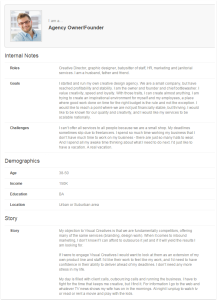
Let’s face it, many businesses get by just winging it when it comes to business strategy. If you really want your business to take off, it’s probably worth investing some time and effort working on your business. With limited time and resources, however, where should you start to really recognize the most bang for your buck? We think a great place to invest some time to help your business grow is in persona development – identifying and getting to know your core customer.
What’s a Persona?
The first step to creating a customer or buyer persona is establishing what the heck a persona even is. Simply put (thanks to Hubspot), a persona is a semi-fictional representation of one of your core customers that help you better understand your core audiences and customers.
Personas are fictional, generalized characters that encompass the various needs, goals, and observed behavior patterns among your real and potential customers. They help you understand your customers better.
Establishing your personas will enable you to have a better understanding of the types of information you should be creating to help guide site visitors through the buyer’s lifecycle, the tone and timbre you should use when creating materials, and where you should focus your outreach efforts in order to get in front of your target audience most effectively. A well-crafted persona “comes to life” as a no-nonsense representation of your core customer – one with whom you can become more familiar the more you hone their description – which leads to an increased level of comfort and understanding that helps guide your outreach and content offers. All of this research should be people-focused rather than company-focused. The key idea behind persona development is to remind us that we sell to other, identifiable people in all our interactions. Though they may represent companies, at the end of the day, we are dealing with interpersonal relationships in all of our business dealings.
How do I develop personas?
The first step to developing personas is to create a list of questions to ask yourself and your team that will help identify the core qualities of your target audience. There are no “right” or “wrong” answers as you start persona development – all answers help hone your core audience characteristics.These representations take into account a wide range of information about your target customer, client, or buyer including:
- Demographics: Age, education-level, income, marital-status, etc.
- Role: This person’s role in his or her company including how their performance is measured, skills required, and to whom they may report
- Interests: Personal and professional interests, hobbies, activities, etc.
- Needs/Goals: What is your persona attempting to accomplish and how will they reach these goals?
- Challenges: What obstacles stand in their way to achieving their goals?
- Watering holes: Where they go to get information about their job. Associations and networks to which they belong. Where they turn to get answers to help them reach their goals and/or overcome challenges.
- Shopping preferences: How they prefer to interact with vendors and where they go online to research vendors or products.
- Company information: Revenue, employee count, industries, etc. (though again, make sure these augment the target personality and don’t get too caught up in company demographics).
- Here is a list of 100 questions you can reference when developing personas.
As you start to answer these questions, you will begin to see trends in your answers and may even be able to identify multiple audiences for whom you can develop personas. In this case, segment your answers to identify a variety of distinct personalities with whom you should interact.
Once you have answered the questions that help build a framework for your personas, develop a story around each one that brings each character “to life”. This story should paint a very clear picture of who you are seeking to entice to visit your business. Focus the story on:
- Roles
- Goals
- Challenges
- Demographics
- The Persona Story
- Name and bio photo
For each of these areas of persona development, more information is better than less. Keep in mind that your personas can evolve over time (as your business changes, you get more familiar with your core customers, or you just get better at developing personas!). These are not static and can change and grow often as you collect more information. The more information you can weave into your personas the better your understanding of your target audience will be – and the better you can be at crafting your outreach to entice them to become your customers.
It’s about PEOPLE
If there is one takeaway from this article, it would be to remember that you are dealing with people not companies. We often hear clients talk about companies they want to go after to help grow their businesses. There is nothing wrong with picking out some big players in your industry (company-wise) but always keep your focus on the people within that company with whom you will need to establish a trusting relationship to help land that big client. Persona development is the first step on the road to successful outreach and converting traffic to customers.

